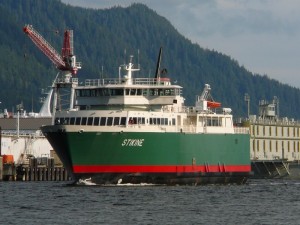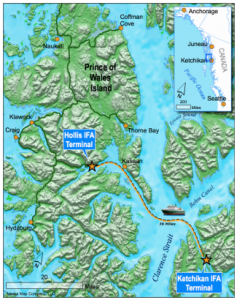A small southern Southeast Alaska ferry line is of large value to the region’s economy. That’s according to a new report studying the Inter-Island Ferry Authority.
The authority, known as the IFA, carries about 52,000 passengers a year.
A single ferry leaves the eastern Prince of Wales Island port of Hollis each morning. It arrives in Ketchikan about three hours later, and then waits ‘til the evening to sail back.

A new study shows it’s an important part of the region’s economy. (Read the report.)
“No one is no more dependent on IFA’s daily timetable than those trying to get fresh or live seafood to market,” says Meilani Schijvens of Juneau-based Sheinberg Associates. She authored the report, funded by a state grant to the authority.
Schijvens says the ferry carries 3 million pounds of seafood a year, with a value of $15 million.
Researchers talked to Prince of Wales Island fishermen, divers and logistics workers for the report.
“And the businesses told us that without the IFA, they wouldn’t be in business,” Schijvens says. She says the ferry also supports seafood processors in Ketchikan.
The report says tourists and others traveling to the island spend close to $6 million a year. And islanders headed to Ketchikan purchase about $10 million in goods.
“We talked to the floor manager in Wal-Mart there and he let us know that approximately 10 percent of all of his customers are coming off the ferry. And those numbers add up,” Schijvens says.

The Inter-Island Ferry Authority study also shows close to 4,000 students sailing the route in a year. About the same number traveled for medical care in Ketchikan or elsewhere.
Other details of economic and human impacts are included in the full report. (Read the report.)
“I think what it means to us is being able to explain to other people what we mean to them,” says Dennis Watson, the IFA’s general manager. He’s also mayor of Craig, the largest city on Prince of Wales.
He says it’s important to note that the ferry authority covers three-quarters of its costs through ticket sales. That‘s far more than the state ferry system, and better than its cousins in Washington state and British Columbia.
Watson says that still leaves about a $750,000 hole in the IFA’s $4 million-a-year budget.
The Parnell administration has put $500,000 in a funding bill, though there’s no guarantee it will make it through the Legislature.
Watson says some of what’s left will be raised internally.
“The board has entertained a fare increase just for adult walk-ons. The seniors and children or vehicles won’t be affected by it,” he says.
That’ll be a few dollars on top of the $46.25 one-way fare.
The Inter-Island Ferry Authority has provided Prince-of-Wales-to-Ketchikan service for about a dozen years. It also ran a northern route for a few seasons, but it didn’t attract enough passengers.
Before that, the Alaska Marine Highway System made port calls, but they were less frequent.
Report author Schijvens says that didn’t do a lot for island residents.
“They absolutely made it work for them at the time. But this is so much better, in terms of being able to have student groups travel, and to go from Prince of Wales to Ketchikan and back again during the day, and not have to get up in the middle of the night, and being able to go one way by ferry and to also come back by ferry,” she says.
Before it began, IFA critics predicted it would have to rely heavily on state funding to survive. The report says conditions have changed and the authority is doing well, given the situation.
That includes fuel costs that have risen five-fold since then and the island’s population shrinking by about a fifth.
Ed Schoenfeld is Regional News Director for CoastAlaska, a consortium of public radio stations in Ketchikan, Juneau, Sitka, Petersburg and Wrangell.
He primarily covers Southeast Alaska regional topics, including the state ferry system, transboundary mining, the Tongass National Forest and Native corporations and issues.
He has also worked as a manager, editor and reporter for the Juneau Empire newspaper and Juneau public radio station KTOO. He’s also reported for commercial station KINY in Juneau and public stations KPFA in Berkley, WYSO in Yellow Springs, Ohio, and WUHY in Philadelphia. He’s lived in Alaska since 1979 and is a contributor to Alaska Public Radio Network newscasts, the Northwest (Public Radio) News Network and National Native News. He is a board member of the Alaska Press Club. Originally from Cleveland, Ohio, he lives in Douglas.




